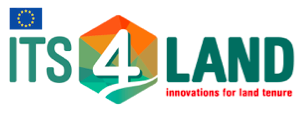What are we doing a little differently?
Transcending Conventions
The project pushes the boundaries of the state-of-the-art with respect to objectives, concepts involved, and the methods and their integration. its4land cuts across multiple continents (2), country contexts (6), technology platforms (4), and disciplinary domains (at least 3). This is absolutely necessary to ensure the correct expertize is included, and that tools are transferrable and scalable.
Converging Ideas
Rarely do land tenure recording program commence with needs assessments focused on market opportunities and realities: large-scale land recording programs are usually government driven, donor backed projects, and give little consideration to the viability and sustainability of the post-project business proposition (Magis and Zevenbergen, 2014). The first objective of its4land focuses on defining user needs using a market driven approach. The second objective focuses on four technologies that are yet to be fully adapted or applied in the land administration domain: UAVs (c.f. Mumbone et al, 2015), smart sketchmaps (c.f. Schwering et al, 2014), automatic feature extraction (c.f. Xiao et al, 2012), and geocloud services (c.f. Zein et al, 2015). Whilst these tools have been applied in mapping more generally, they are yet to be adequately adapted, and certainly not fully integrated, in any previous land administration work. The third objective focuses on governance: land and ICT governance is an emerging area of inquiry and certainly understood as integral to the success of land tenure interventions, however, it is not usual that the governance aspect is so intimately linked to the design process and variable approaches to governance are considered – as is the case in this project.
Adapting Novel Methods
The actor-network analysis and graph theory approach intended for the needs assessment and governance model work has not been applied in sub Saharan Africa at the intended scale, or in the domain of land administration. The unique ontological analysis approach intended for the work on smart sketchmaps, and the related data model, are complementary and new additions to work already completed on STDM and LADM. UAV mapping procedures have been trialled in a limited fashion in other mapping activities in the three case countries, however, they have not been applied in the land tenure mapping context. The transdisciplinary nature of the work means also that the methods are intertwined, feeding from one phase, and work package, to the next.
Using New Technologies
A UAV, especially adapted to land administration activities awaits creation – as does software and workflows integrating UAVs with other land administration processes, including adjudication, demarcation, recording, and dissemination. UAVs and usage proliferated over the last 5 years; however, this proposal provides the private consortium partners the opportunity to adapt the tools to the rapidly emerging markets in sub Saharan Africa – and more globally. There exists no tool like the smart sketchmap in the domain on land administration: the concept is simply not conceived and is untested in the domain. The same applies to automatic feature extraction algorithms – existing approaches cover topographic features like roads or buildings in lower resolved images. These two tools could revolutionize land tenure data collection and analysis – radically reducing costs and time spent in the field. The Land Administration Domain Model (LADM) is now an ISO standard (ISO19152, and its software implementation, the Social Tenure Domain Model (http://www.stdm.gltn.net/) is also open-access and open-source. In this regard, there exists the opportunity to tailor a standardized model for alternative land tenure recoding in sub Saharan Africa. This exciting opportunity is yet to be fully exploited by any major players in the domain, despite predilections espoused by larger players including ESRI (also a partner in this project). Geocloud services are particularly unexploited in the land administration domain. The consortium has a head start in this regard: ESRI Rwanda helped to pioneer the first land use portal in sub Saharan Africa in 2014.
Complementing Others
Emerging examples of geocloud services, intending to use rapid uptake in smart phones across sub Saharan Africa – and fill the gap in land tenure recording – include Missing Maps (missingmaps.com), Landmapp (landmapp.net), and Cadasta (cadasta.org). The opportunity to collaborate with these partners – several also focused on open source alternatives – is provided via the links with UT’s School of Land Administration Studies. The first phase, focused on needs assessment, utilizes actor-network software analysis tools successfully developed in the Netherlands, and previously applied by KUL in Belgium. To date, the selected tools have been primarily used in the research domain; however, there exists scope to commercialize the tools – particularly for large-scale multi-sector and multi-level interviews. Likewise, the third phase offers the opportunity to develop governance and capacity building packages that can be transferred across sub Saharan Africa, and more broadly, with regards to the land administration domain. This could be done on either commercial or open access basis – depending on which business model is deemed most suitable.

Recent Comments